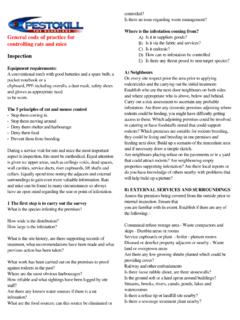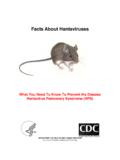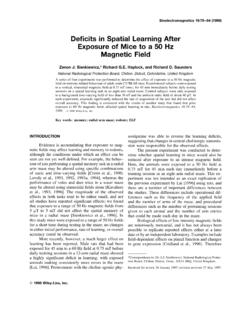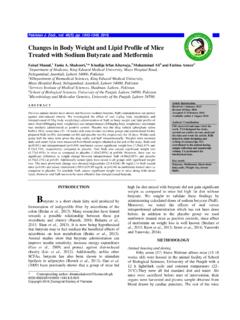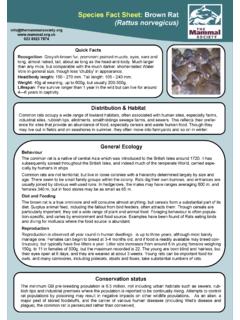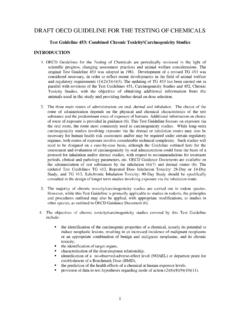Transcription of The Two-Year Rodent Carcinogenesis Bioassay — …
1 J Toxicol Pathol 2007; 20: 13 19. Review The Two-Year Rodent Carcinogenesis Bioassay will It Survive? Jerrold M. Ward1. 1. Comparative Medicine Branch, National Institute of Allergy and Infectious Diseases, National Institutes of Health, Bethesda, Maryland 20892 8135 USA. Abstract: For over 35 years, many synthetic and natural chemicals have been tested by government agencies, private companies and research institutes for carcinogenic activity in rats and mice in classical 2 year studies as part of a toxicity profile ultimately used for human toxicity and carcinogenicity risk assessment. With an increasing number of pharmaceutical and agricultural chemicals shown to be carcinogenic in these bioassays , research into the mechanisms of toxicity and Carcinogenesis has intensified. The relevance of the induced tumors in rodents has been questioned after much research. Research has provided evidence to some scientists that doses used in the bioassays may represent situations where toxicity pathways do not develop in humans exposed to levels of these chemicals, toxicity itself may create situations where tumors develop only under those situations, species specific responses may exist, and tumors induced may not be relevant to human risk.
2 Regulatory agencies have considered these and other factors when preparing regulatory decisions on regulation of these chemicals. Thus, the USA FDA often has approved drugs despite their carcinogenicity in rodents and the USA EPA has explored many situations where considerations of the mechanisms of Carcinogenesis in rodents and humans play a role in their regulatory decisions. Unfortunately, much of the decisions are based on unproven and hypothetical mechanisms of Carcinogenesis in rodents and humans. Despite this situation, the impact of these decisions on future considerations and decisions for regulation of chemicals suggests that the US. regulatory agencies consider that the occurrence of increased incidences of tumors in standard 2 year Rodent Carcinogenesis Bioassay is often not relevant to human Carcinogenesis risk assessment. (J Toxicol Pathol 2007; 20: 13 19). Key words: Bioassay , Carcinogenesis , rodents, toxicology Introduction and scientific committees during the past ten years1 9.
3 The federal regulatory agencies in the United States and other Natural and manmade chemicals have been evaluated countries have responded. Numerous drugs that have caused for their toxicity in rats and mice for over 40 years in order tumors in rodents in 2 year Carcinogenesis bioassays are on to provide information to be used for estimating risks to the market, approved for use by the regulatory agency humans. Of particular popularity has been the 2 year responsible for assessing efficacy and safety10,11. The EPA. Carcinogenesis Bioassay . It has always been assumed that evaluates mechanism of Carcinogenesis of environmental the acute and chronic toxicity of a specific chemical in agents prior to approving their use. This review will present rodents has relevance to the risk of acute and chronic toxicity the major issues involved. and Carcinogenesis in humans. With the discovery of the toxicity of chemicals found naturally in the environment and History of the Bioassay the growth of the pharmaceutical industry during the past 20.
4 Years, it has become evident that there are numerous toxins Chemicals in our environment include pharmaceutical and Rodent carcinogens that humans are exposed to on a daily agents, food additives, industrial intermediates, agricultural basis. The relevance of the carcinogenicity findings in rats chemicals, natural endogenous and exogenous chemicals and and mice to human risk has been investigated, reviewed and air pollutants. Most are potentially toxic to living creatures challenged in many publications by individuals, institutions including wild animals, insects, laboratory rodents, domesticated animals and humans. Since Percivall Pott showed that chimney soot was associated with scrotal cancer Received: 26 December 2006, Accepted: 16 January 2007. and Yamigiwa & Ichikawa first showed that coal tar could Mailing address: Jerrold M. Ward, CMB, NIAID, NIH, Bethesda, MD. 20892 8135 USA. cause skin cancer in rabbits, it was assumed that chemicals TEL: 1-301-402-5620 FAX: 1-301-480-2343 that humans are exposed to may lead to toxic and E-mail: carcinogenic hazards 1 2, 1 3.
5 Thus, the various federal 14 Rodent Carcinogenesis Bioassay government regulatory agencies developed rules and been characterized as to incidence and pathology including regulations for chemicals that humans may be exposed to at natural history 34 38 . Rodents do not commonly develop work, in the air, at home, in food and medications. Much of spontaneous tumors most prevalent in humans including these regulations accelerated in the 1970s when agricultural those of the colon and prostate, in part, due to differences in chemicals were found to be carcinogenic in rodents. At first genetics, diet, specific natural chemical exposures and simple bioassays were developed which exposed rats or mice infectious agents. to a test chemical in the diet, by gavage or by inhalation for Naturally occurring and induced tumors of rats and up to 2 years13. Chemicals were given usually at 2 doses and mice progress through a sequence of histomorphologic and controls were used.
6 The highest doses were at a maximally when known, molecular events38. In epithelial tissues the tolerated level, which was subsequently defined as a dose first visible evidence of neoplastic progression is a focal which would produce not more than 10 15% depression in proliferative lesion followed by focal nodular lesions and body weight gain, early illness or death due to the chemical. benign neoplasia. Benign neoplasia can progess to The largest efforts in using, developing and improving these malignant neoplasia, especially in skin, liver, and lung. bioassays were first done by The US National Cancer Epithelial lesions lining tubular organs often develop Institute in the 1970s until the formation of The National dysplastic lesions which can progress to malignancy. The Toxicology Program under the leadership of the National rodents lesions are not unlike those observed in humans Institute of Environmental Health Sciences in the late except for the more common benign tumors progressing to 1970s 14.
7 Since that time, various guidelines have been malignancy in rodents. Also, some normal Rodent tissues developed by regulatory agencies and have evolved for use in (especially mammary gland and prostate) and Rodent tumors requirements for Carcinogenesis testing in the USA and other often have less stroma than do their human counterparts. countries (The US FDA Redbook ( Some scientists have suggested over the years that Rodent ~ ); the US EPA guidelines for tumors were, in fact, not tumors but lesions of hyperplasia carcinogenicity risk assessment, and reactivity to toxic damage of an organ1,39. ; European and international guidelines, ). The Human Carcinogens Some old concepts still exist, however, such as The Delaney Clause of the Federal Food Drug and Cosmetic Act of 1958 Many chemicals or processes, viruses, bacteria, which states that no additive will be deemed safe if it is parasites, and irradiation have been associated with increased found to induce cancer when ingested by man or animal.
8 15. cancer risk in humans, as studied by epidemiological Advances in using rodents for human Carcinogenesis risk investigations ( assessment have been suggested16. , ) 28,40 . Since that time, over 500 chemicals were tested for Most all of these chemicals or processes cause tumors in rats toxicity and Carcinogenesis by the US government and or mice 28,41 . IARC reports that 400 agents have been probably over 1500 chemicals by various sponsors identified as carcinogenic or potentially carcinogenic to throughout the world17 20. The International Agency for humans ( ). Many of these chemicals, but not all Research in Cancer (IARC) and its expert committees have of them, are multiple organ Rodent carcinogens and most are reviewed data on over 900 agents ( ). genotoxic28. Human cancer drugs carry increased risk for This large amount of accumulated data has led to questions secondary cancers 10 30 years later ( , IARC. concerning the validity of the standard 2 year Bioassay for monographs, volumes 50 and 66).
9 Uses in human risk assessment 2,21 30 . Most recently, modifications in standard procedures have been suggested Human Pharmaceutical Agents are Often Rodent and used by many interested parties31 33. Carcinogens The Rodent Carcinogens and Pathology of In light of the great expansion of the pharmaceutical Rodent Tumors industry over the past 30 years, many drugs have been developed for promoting human health. During this Over the past 50 years, many chemicals (probably development, many prospective drugs have been found to be thousands) have been shown to cause tumors in rodents with carcinogenic in 2 year Rodent studies. Despite these laboratory experiments (by oral administration, injection of findings, the drugs are often approved based on important newborns or adults, inhalation, or gavage) of short or long efficacy in humans and risk/benefit analysis by FDA for use term even up to the lifetime of the animals. These studies in humans, either as prescription drugs or over the counter.
10 Have induced tumors in various tissues most commonly in Many advisory committees in the USA provide guidance to liver, lung, skin and mammary gland17,20. the US regulatory agencies. For reasons that are not Naturally occurring tumors of rats and mice occur in a published, the regulatory agencies have approved for human sex, age and strain or stock dependent manner. Those of the use many drugs which cause tumors in Rodent studies 11. most common strains and stocks of mice (CD-1, B6C3F1) Fortunately, most of these drugs are not genotoxic. and rats (F344, Sprague-Dawley) used in toxicology have Regulatory agencies use rules, regulations and guidelines for Ward 15. Table 1. Cholesterol-Lowering Drugs Are Rodent Carcinogens Generic name Trade name Web Site Tumors in rats Tumors in mice Atorvastatin Lipitor Sarcomas Liver Clofibrate none Liver Liver Colesevelan Welchol Pancreas, thyroid none Fenofibrate Tricor Liver, pancreas, testis Liver Fluvastatin Lescol Stomach, thyroid Stomach Gemfibrozil Lopid Liver, testis none Lovastatin Mevacor Liver, thyroid Liver, lung, stomach Pravastatin Pravachol Liver Liver, lung Rosuvastatin Crestor Uterine polyps Liver Simvastatin Zocor Thyroid, liver Liver, lung, harderian gland Most information is not published in referred journals but is available in product sheets.
